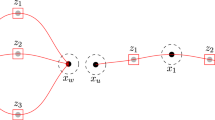Abstract
We investigate the worst possible behavior of a stationary traffic source when the traffic emanating from it is required to meet certain constraints. Specifically, the peak rate of the source is required not to exceed a level ρ and realizations must obey a “leaky bucket” constraint with bucket size β and leak rate σ. The worst case source is considered to be the one with the largest effective bandwidth, a concept which arises in the large deviation theory of queueing networks and governs the asymptotic loss rate when a large number of sources send traffic to a single server queue. We conjecture the form of the worst case traffic in general and prove the conjecture for the special case when T, the time-scale parameter of the effective bandwidth, is less than both β/(ρ−σ) and β/σ, the times taken respectively to fill and empty the leaky bucket.
Similar content being viewed by others
References
R. Boorstyn, A. Burchard, J. Liebeherr and C. Oottamakorn, Statistical service assurances for traffic scheduling algorithms, IEEE J. Selected Areas Commun. 18(12) (2000) 2651–2664.
D.D. Botvich and N.G. Duffield, Large deviations, the shape of the loss curve, and economies of scale in large multiplexers, Queueing Systems 20 (1995) 293–320.
C. Courcoubetis, F. Kelly and R. Weber, Measurement-based usage charges in communication networks, Oper. Res. 48 (2000) 535–548.
C. Courcoubetis and R. Weber, Buffer overflow asymptotics for a buffer handling many traffic sources, J. Appl. Probab. 33 (1996) 886–903.
R.L. Cruz, A calculus for network delay, part I: Network elements in isolation, IEEE Trans. Inform. Theory 37(1) (1991) 114–131.
B.T. Doshi, Deterministic rule based traffic descriptors for broadband ISDN:Worst case behavior and connection acceptance control, in: Proc. of the 14th ITC, Antibes Juan-les-Pins, June 1994, pp. 591– 600.
F.P. Kelly, Notes on effective bandwidths, in: Stochastic Networks: Theory and Applications, eds. Kelly, Zachary and Ziedins (Oxford Univ. Press, Oxford, 1996) pp. 141–168.
G. Kesidis and T. Konstantopoulos, Extremal shape-controlled traffic patterns in high-speed networks, IEEE Trans. Commun. 48(5) (2000) 813–819.
G. Kesidis and T. Konstantopoulos, Extremal traffic and worst-case performance for queues with shaped arrivals, in: Analysis of Communication Networks: Call Centres, Traffic and Performance, Toronto, ON, 1998, Fields Institute Communications, Vol. 28 (Amer. Math. Soc., Providence, RI, 2000) pp. 159–178.
D.C. Lee, Effects of leaky bucket parameters on the average queueing delay: Worst case analysis, in: Proc. of IEEE Infocom '94, Toronto, Canada, June 1994, pp. 482–489.
F. LoPresti, Z. Zhang, D. Towsley and J. Kurose, Source time scale and optimal buffer/bandwidth trade-off for regulated traffic in an ATM node, in: Proc. of IEEE Infocom '97, Kobe, Japan, April 1997, pp. 347–355.
B. McGurk and C. Walsh, Investigations of the performance of a measurement-based connection admission control algorithm, in: Proc. of ATM '97 – 5th IFIP Workshop on Performance Modelling and Evaluation of ATM Networks, Ilkely, UK, July 1997.
D. Mitra and J.A. Morrison, Multiple time scale regulation and worst case processes for ATMnetwork control, in: Proc. of the 34th Conf. on Decision and Control, New Orleans, LA, December 1995, pp. 353–358.
P. Oechslin, In search of the worst case arrivals of independent leaky bucket constrained sources, in: Proc. UKPEW, Bradford, July 1997, pp. 100–106.
M. Reisslein, K.W. Ross and S. Rajagopal, Packet multiplexers with adversarial regulated traffic, in: Proc. of IEEE Infocom '98, San Francisco, April 1998, pp. 347–355.
Traffic management specification version 4.0, Technical Report 95-0013R10, ATM Forum (February 1996).
J.S. Turner, New directions in communications (or which way to the information age?), IEEE Commun. Mag. 24(10) (1986) 8–15.
C. Walsh, Worst case traffic from regulated traffic sources, Technical Report HPL-BRIMS-01-01, HP Labs (2001) www.stp.dias.ie /~walsh / regulated.ps.
Author information
Authors and Affiliations
Rights and permissions
About this article
Cite this article
Walsh, C. Maximal Effective Bandwidth of Constrained Traffic. Queueing Systems 44, 161–182 (2003). https://doi.org/10.1023/A:1024472521936
Issue Date:
DOI: https://doi.org/10.1023/A:1024472521936




